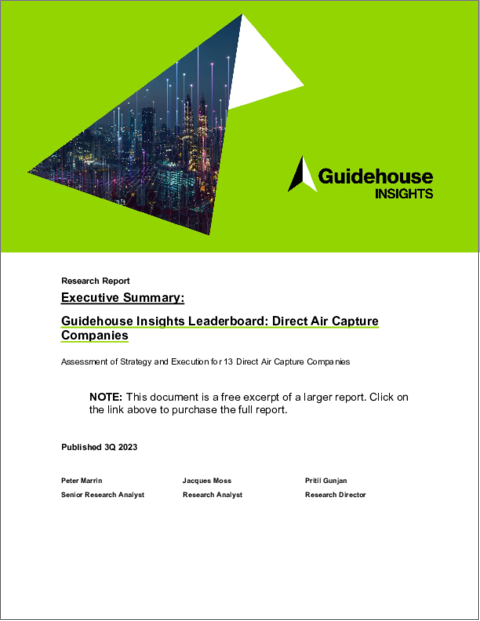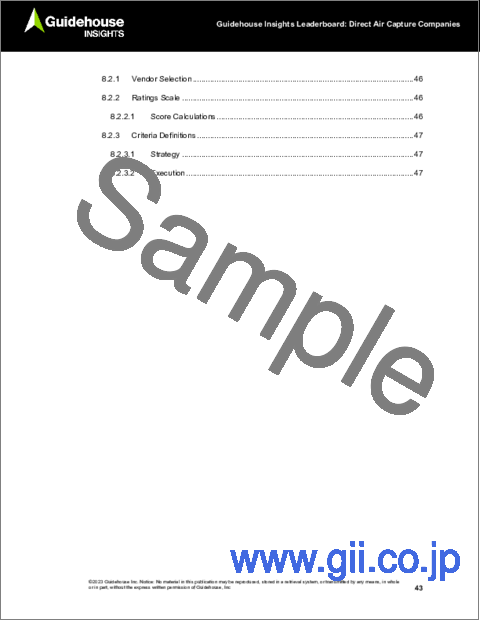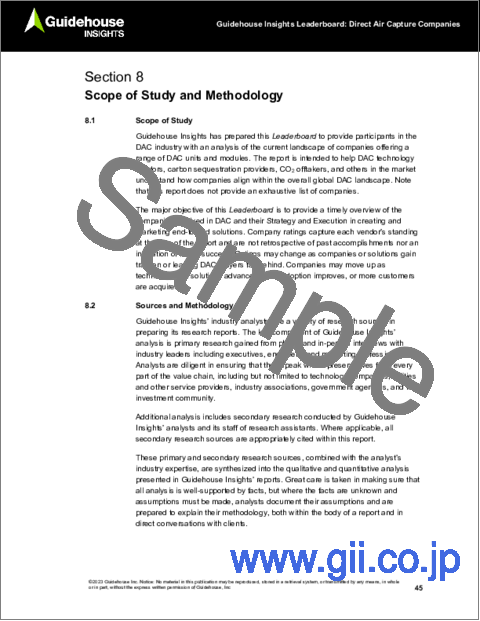|
|
市場調査レポート
商品コード
1328596
Guidehouse Insights Leaderboard Report:DAC (Direct Air Capture) 企業 - DAC企業13社の戦略・実行力の評価Guidehouse Insights Leaderboard Report - Direct Air Capture Companies: Assessment of Strategy and Execution for 13 Direct Air Capture Companies |
||||||
|
|||||||
| Guidehouse Insights Leaderboard Report:DAC (Direct Air Capture) 企業 - DAC企業13社の戦略・実行力の評価 |
|
出版日: 2023年08月01日
発行: Guidehouse Research
ページ情報: 英文 49 Pages; 18 Tables, Charts & Figures
納期: 即納可能
|
- 全表示
- 概要
- 図表
- 目次
DAC (Direct Air Capture) のような炭素除去技術は、気候変動緩和に向けた世界規模の推進において重要な役割を果たすと思われます。DACは、空気中のCO2を直接吸引することで、再生可能な電力で稼働し、CO2の永久貯蔵と組み合わせれば、マイナスエミッション技術となります。また、回収したCO2は、他のセクターからの排出を削減するために使用することもできます。
DACプロジェクトは現在、稼働中の炭素回収利用・隔離プロジェクトの約5%を占めているが、プロジェクトの規模は非常に小さく、世界のCO2回収設備容量の0.02%にも満ちません。ほとんどのDACプロジェクトがこれほど小規模である理由のひとつは、この技術が比較的未成熟で、まだ試験と最適化が行われていないことです。2015年までに、DAC企業は世界でわずか4社しか操業していませんでした。しかしこの5年間で、新しく革新的な技術とアプローチを持つ第二世代の企業がこの分野に参入してきました。DACの普及を阻むもうひとつの要因は、そのコストの高さです。スケールメリットを生かした大規模なプロジェクトを計画することで経費削減を目指すDAC企業もあれば、プロジェクトの初期費用を最小限に抑えるため、必要に応じて追加ユニットを配備するモジュール方式を採用する企業もあります。
このGuidehouse Insights Leaderboardでは、主要13社のDAC製品を調査し、最も有用なDACソリューションを提供している企業を決定するため、各社を比較評価しています。
目次
第1章 エグゼクティブサマリー
第2章 市場概要
- 市場の定義
- 市場促進要因
- 市場抑制要因
- 市場動向
第3章 Guidehouse Insights Leaderboard
- Guidehouse Insights Leaderboardのカテゴリー
- リーダー
- コンテンダー
- チャレンジャー
- フォロワー
- Guidehouse Insights Leaderboardのグリッド
第4章 企業ランキング
- リーダー
- Climeworks
- コンテンダー
- Carbon Engineering
- Global Thermostat
- Baker Hughes/Mosaic Materials
- CarbonCapture
- Aircapture
- Carbyon
- Noya
- Prometheus Fuels
- チャレンジャー
- Mission Zero
- Verdox
- Sustaera
- Carbominer
第5章 頭字語・略語の一覧
第6章 目次
第7章 図表
第8章 分析範囲・手法
List of Figures
The Guidehouse Insights Leaderboard Grid: Direct Air Capture Companies
Climeworks Strategy and Execution Scores
Carbon Engineering Strategy and Execution Scores
Global Thermostat Strategy and Execution Scores
Baker Hughes/Mosaic Materials Strategy and Execution Scores
CarbonCapture Strategy and Execution Scores
Aircapture Strategy and Execution Scores
Carbyon Strategy and Execution Scores
Noya Strategy and Execution Scores
Prometheus Fuels Strategy and Execution Scores
Mission Zero Strategy and Execution Scores
Verdox Strategy and Execution Scores
Sustaera Strategy and Execution Scores
Carbominer Strategy and Execution Scores
Carbon removal technologies such as direct air capture (DAC) will play a key role in the global push for climate change mitigation. By sucking CO2 directly from the air, DAC can be a negative emissions technology when run on renewable electricity and coupled with permanent CO2 storage. Alternatively, the captured CO2 can be used to reduce emissions from other sectors.
DAC projects currently account for about 5% of the carbon capture utilization and sequestration projects in operation, but the projects are very small scale, representing less than 0.02% of total installed global CO2 capture capacity. One reason most DAC projects are so small is that the technology is relatively immature and still undergoing testing and optimization. By 2015, only four DAC companies were operating around the world. Over the last five years, however, a flood of second-generation companies has entered the space with new and innovative technologies and approaches. Another impediment to DAC uptake is its high costs. While some DAC companies aim to cut expenses by planning large-scale projects to leverage economies of scale, others are taking a modular approach, preferring to deploy additional units as necessary in order to minimize initial upfront costs for a project.
This Guidehouse Insights Leaderboard examines the DAC offerings from 13 leading companies and measures them against one another to determine which are providing the most useful DAC solutions.
Top 10 Vendors
1. Climeworks
2. Carbon Engineering
3. Global Thermostat
4. Baker Hughes/Mosaic
5. CarbonCapture
6. Aircapture
7. Carbyon
8. Noya
9. Prometheus Fuels
10. Mission Zero
Table of Contents
1. Executive Summary
- 1.1 Market Introduction
- 1.2 Vendor Selection
- 1.3 The Guidehouse Insights Leaderboard Grid
2. Market Overview
- 2.1 Market Definition
- 2.2 Market Drivers
- 2.3 Market Barriers
- 2.4 Market Trends
3. The Guidehouse Insights Leaderboard
- 3.1 The Guidehouse Insights Leaderboard Categories
- 3.1.1 Leaders
- 3.1.2 Contenders
- 3.1.3 Challengers
- 3.1.4 Followers
- 3.2 The Guidehouse Insights Leaderboard Grid
4. Company Rankings
- 4.1 Leaders
- 4.1.1 Climeworks
- 4.2 Contenders
- 4.2.1 Carbon Engineering
- 4.2.2 Global Thermostat
- 4.2.3 Baker Hughes/Mosaic Materials
- 4.2.4 CarbonCapture
- 4.2.5 Aircapture
- 4.2.6 Carbyon
- 4.2.7 Noya
- 4.2.8 Prometheus Fuels
- 4.3 Challengers
- 4.3.1 Mission Zero
- 4.3.2 Verdox
- 4.3.3 Sustaera
- 4.3.4 Carbominer
- 4.4 Followers
5. Acronym and Abbreviation List
6. Table of Contents
7. Table of Charts and Figures
8. Scope of Study and Methodology
- 8.1 Scope of Study
- 8.2 Sources and Methodology
- 8.2.1 Vendor Selection
- 8.2.2 Ratings Scale
- 8.2.2.1 Score Calculations
- 8.2.3 Criteria Definitions
- 8.2.3.1 Strategy
- 8.2.3.2 Execution






